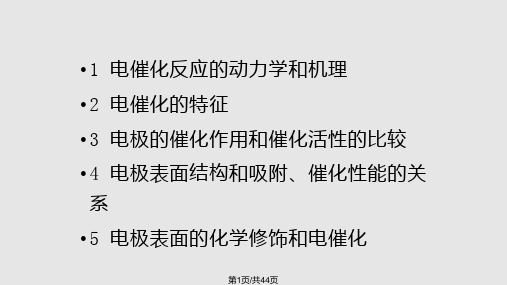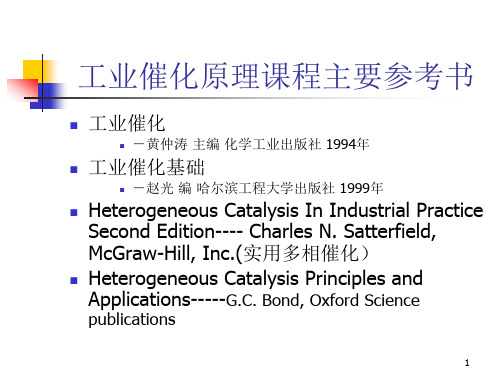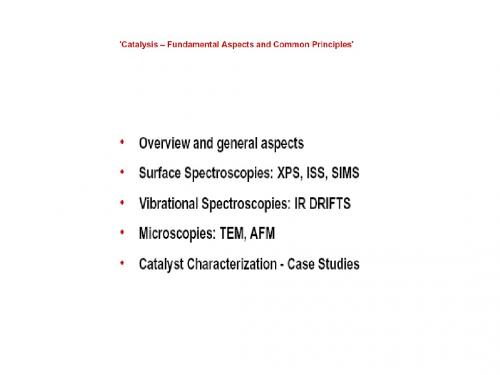催化化学课件英文版2
《电化学催化》课件

电化学催化的基础知识
1 电化学过程的基本概念
2 催化反应的基本原理
了解电化学过程的基本概念,例如电极 反应、离子迁移和电流密度等。
探究催化反应的基本原理,如催化剂吸 附、活化能降低和反应速率等。
原位研究电化学催化反应Fra bibliotek1原位研究的技术与方法
了解原位研究电化学催化反应的现有技术与方法,如电化学原位红外光谱和原位 电子显微镜等。
2 电化学催化的应用于水分解制氢
了解电化学催化在水分解制氢中的作用,包括催化剂的设计和电解过程的优化等。
结论
电化学催化的发展趋势
展望电化学催化的未来发展方向,包括新 型催化剂的设计和先进研究技术的应用。
电化学催化研究的挑战和未来展 望
探讨电化学催化研究面临的挑战,并展望 未来在可持续能源转换方面的应用。
《电化学催化》PPT课件
欢迎使用《电化学催化》PPT课件! 在此课程中,我们将深入探讨电化学催化 的基本概念,应用领域和研究进展,从而为您打开电化学催化的奇妙世界。
简介
什么是电化学催化
电化学催化研究电化学过程中催化剂的作用机制,以促进反应速率或调控产物选择性的科学 领域。
电化学催化的应用领域
电化学催化广泛应用于能源转换、环境保护、电化学合成和生物电化学等领域。
2
原位研究的应用案例
探索原位研究在电化学催化领域中的应用案例,如催化剂失活机制的研究和催化 反应中的界面现象等。
电化学催化剂的设计和合成
催化剂的种类
了解不同类型的电化学催化剂,如金属催化 剂、有机催化剂和生物催化剂。
催化剂的设计和合成方法
学习电化学催化剂的设计和合成方法,如原 位合成、溶液合成和纳米材料制备等。
九级化学上册探究专题课件催化剂和催化作用(共12张PPT)

探究专题(二) 催化剂和催化作用
探究1 对不同催化剂催化效果的探究:某小组同学选择“过氧化氢溶 液生成氧气的快慢与什么因素有关”的课题进行研究,以下是他们探
究的主要过程:
[进行猜想] 假设过氧化氢溶液生成氧气的快慢与催化剂的种类有 关。 [实验方案] 常温下,在两瓶相同体积、相同浓度的过氧化氢溶液中分别 加入二氧化锰和红砖粉,测量各生成一瓶(相同体积)氧气所需要的时 间。
_有__气_泡_放_出____; 氧化铜的质量仍然
__________
带火星的
为0.2 g
__________
木条复燃
步骤⑦结果
有气泡 放出;
带火星的木条
_复_燃________ __________
结论 猜想 Ⅰ、Ⅱ 不成立; 猜想Ⅲ 成立
探究专题(二) 催化剂和催化作用
(2)步骤①的目的是 _与_步__骤_③__对_比__,_检__验_加__入_氧__化_铜_前__后_过__氧_化__氢_的__分_解__速_率__有_无________。
Hale Waihona Puke 探究专题(二) 催化剂和催化作用
过氧化氢在常温下分解缓慢,加入二氧化锰或红砖粉后反应明显加快, 若要证明二氧化锰或红砖粉是不是该反应的催化剂,还需要增加实验来
质量
验证它们在化学反应前后的________和____________是否改变。
化学性质
探究专题(二) 催化剂和催化作用
探究2 催化剂的用量对反应速率的影响的探究:每次均用30 mL 10%的过 氧化氢溶液,采用不同量的二氧化锰粉末作催化剂,测定各次收集到 500 mL氧气时所用的时间,结果如下:(其他实验条件均相同)
探究专题(二) 催化剂和催化作用
催化作用基础英文版

催化作用基础英文版Catalysis is a process that increases the rate of a chemical reaction by providing an alternative pathway with lower activation energy for the reaction to occur. It involves the use of a catalyst, which is a substance that increases the rate of a chemical reaction without being consumed in the process. Catalysts play a crucial role in various industrial processes, such as the production of fuels, chemicals, and pharmaceuticals.Surface catalysis, on the other hand, occurs when the catalyst provides a surface on which the reactant molecules can adsorb and react. The catalyst surface can provide active sites that enable the reactants to undergo specific reactions. Surface catalysis is particularly important in heterogeneous catalysis, where the reactant molecules need to adsorb onto the catalyst surface to initiate the reaction.In conclusion, catalysis is a fundamental process that significantly enhances the rate of chemical reactions. It involves the use of catalysts, which provide alternative pathways with lower activation energy, allowing reactions to proceed at a faster rate. Catalysis plays a crucial role in various industrial processes and can be classified into homogeneous and heterogeneous catalysis. It can also be categorized based on the mechanism and selectivity of the catalyst. Understanding and harnessing catalysis is essentialfor the development and optimization of efficient and sustainable chemical processes.。
电化学催化PPT课件

Faraday吸附及多态化学吸附的解释
• Faraday吸附过程可一般表示为 A z+ +ze-→Aad Aad 表示吸附物种 当通过电量dq时,电极基体上吸附物Aad 的覆盖度变化dθ可以表示为
dq=qmon dθ qmon:形成完整单层所需的 第9页/共44页 电量
Faraday吸附满足不同的吸附等 温
第31页/共44页
分子的吸附作用
• 电极表面上吸附状态的分子有H2O,CO,CH3OH,HCOOH,HCHO和H2等。
• 大多数电极反应是在水溶液中进行的,电极/水溶液界面双电层的电性质,特别是 界面微分容量和电极表面水分子的吸附状态有密切关系。人们已提出了水分子吸附 状态的多种模型。核心是表面吸附的水分子是呈单分子、双分子,还是和氢结合程 度不同的簇。多晶金电极表面的水分子是以簇的状态存在,同时其密度和定向则随 电位而变。
第21页/共44页
2 电催化的特征
• (1). 电极电位是重要的观察参数,特别是对组成一定 的体系,超越平衡电位的电极电位(超电位)是使反应进 行的驱动力(自由能降低大,-△G),也称为亲和力 (affinity)。这在研究反应动力学的特性时有重大意义。
• (2). 可利用外部回路(例如,恒电位)控制超电压, 使反应条件/反应速度较易控制,且可实现剧烈的电解和 氧化-还原条件。
H3O+ + e— + M = MH + H2O (酸性溶液中)
或
H2O + e— + M = MH + OH— (中性或碱
性溶液中)
(ⅱ)复合脱附步骤 MH + MH → 2M + H2
(ⅲ)电化学脱附步骤:
催化剂PPT授课课件

基础巩固练
【点拨】由题图可知,小球从 D 点运动到 F 点的路程 s= 12.50 cm-4.50 cm=8.00 cm=0.08 m,时间 t=2×0.2 s= 0.4 s,速度 v=st=00.0.48 sm=0.2 m/s。
使带火星木条复 化氢的分解速率
燃的气体
Ⅱ.向B试管中
红砖粉末的___质__量___
重新加入5%的 ①又产生大量能 和_化__学__性__质___ 在反应
过氧化氢溶液,使带火星木条复 前后均没有发生变化,
反应停止后过 燃的气体
能作过氧化氢分解的
滤、洗涤、干 ②滤渣质量为a g 催化剂
燥、称量滤渣
HK版 八年级上
【答案】8.00;0.2
能力提升练
10.[中考·江苏泰州]如图是“研究气泡的运动规律”实验 装置。
(1)实验时所用的测量工具是刻度尺和___秒__表___。 (2)要正确判断气泡是否做匀速直线运动,需要对气泡
运动时的相关物理量进行测量,为便于测量,就使 气泡在管内运动得较___慢_____(填“快”或“慢”),气泡 的运动如果是匀速直线运动,收集到的数据特点是运动的 路程和时间成____正____比。
2. 太空舱利用NiFe2O4将航天员呼出的CO2转化为O2,
而NiFe2O4的质量和化学性质在反应前后都不变。则
NiFe2O4在该过程中是( D )
A. 反应物
B. 生成物
C. 消毒剂
D. 催化剂
3. 【2020•东莞】实验室用过氧化氢制氧气的实验中, 应加入少量二氧化锰。下列说法中正确的是( D ) A. 只有二氧化锰能作过氧化氢分解的催化剂 B. 二氧化锰只能作过氧化氢分解的催化剂 C. 加入二氧化锰可以增加过氧化氢分解产生氧气 的质量 D. 二氧化锰能加快过氧化氢分解
《催化反应动力学》课件

工业催化反应
石油化工
催化裂化、加氢裂化、烷基化等,提高油品质量 和产量。
精细化工
有机合成、高分子合成、药物合成等,生产高附 加值化学品。
环保领域
脱硫、脱硝、污水处理等,降低污染物排放,保 护环境。
环境催化反应
大气污染治理
催化燃烧、光催化分解等,降低空气中的有害气体和颗粒物。
水处理
催化氧化、光催化氧化等,去除水中的有害物质和重金属离子。
土壤修复
利用催化剂降解土壤中的有机污染物,降低污染风险。
新材料合成中的催化反应
高分子材料
利用催化合成技术,制备高性能高分子材料 。
纳米材料
通过催化反应控制纳米材料的形貌和尺寸, 制备具有特殊性能的纳米材料。
复合材料
利用催化反应将不同材料复合在一起,制备 具有优异性能的复合材料。
06
总结与展望
本章总结
实验步骤与操作
01
实验操作注意事项
02 1. 确保实验器材和试剂的清洁度,避免污 染。
03
2. 严格控制实验温度和压力,确保实验条 件的准确性。
04
3. 在实验过程中,密切关注反应情况,如 有异常及时处理。
数据处理与分析
01
数据处理方法
02 1. 将实验数据整理成表格,列出各物质浓度的变 化。
03 2. 根据反应动力学方程,计算反应速率常数、活 化能等参数。
《催化反应动力学》 PPT课件
目录
• 引言 • 催化反应动力学基础 • 催化反应动力学模型 • 催化反应动力学实验 • 催化反应动力学应用 • 总结与展望
01
引言
课程简介
催化反应动力学是化学工程学科中的一门重要 课程,主要研究催化剂对化学反应速率的影响 。
光催化氧化过程PPT课件

– 与无机离子的反应
电子转移
O C H d O H C 2 d O N H iO H N 2 i O T H 3 iO H T 4 i O H C2 3-O O H C-3O O H Br -3 O OH Br 3O
10
– 与无机离子的反应
夺氢反应
O H HC -3 H O 2O C-3O O H- 4 S H O 2 O S- 4 O O H H-3 S O H 2O S-3 O
<500
100± 20 < 3 × 1 0 -5 < 4 × 1 0 -2 (3 ± 1 )× 1 0 -2 (3± 3) × 103
K · OH M -1s -1 7 .8 × 1 0 9 3 .9 × 1 0 9 3 .0 × 1 0 9 7 .5 × 1 0 9 1 .3 × 1 0 8 1 .6 × 1 0 7 1 .4 × 1 0 6 3 .1 × 1 0 8 2 .2 × 1 0 10 3 .2 × 1 0 9 8 .5 × 1 0 7 7 .7 × 1 0 6 3 .1 × 1 0 8 1 .6 × 1 0 10
活泼自由基:·OH, ·OOH, ·O2-
27
0 Vacuum
E (NHE)
-2
SiC SrTiO3
-2
CdS
-4 CdSe
ZnO WO3TiO2
ZnS
BaTiO3
3.0
Fe2O3
SnO2
0
3.2
CdO
1.7 2.5
-6
3.2 3.2 3.2
3.7
3.2 2.2
2.1 2
3.8
-8 4
28
常用的半导体光催化剂:TiO2、CdS、 ZnO、WO3、Fe2O3、SnO2、SrTiO3等 其中催化活性最高: TiO2 、CdS、ZnO CdS、ZnO在光照时不稳定,金属离子溶 出;其优势在能隙较小,可吸收可见光。 TiO2 :不发生光腐蚀;耐酸碱性好,化学 性质稳定;对生物无毒性;来源丰富;能 隙较大(3.2ev,最大入射波长为 387.5nm),有很强的氧化还原能力;
《催化加氢》PPT课件

具有体心或面心立方晶格或六角晶格
➢ 提高活性组分的含量,对提高活性有利,加氢精制催化剂
的活性组分的含量一般在 15%~35%之间
➢ 在工业催化剂中,不同的活性组分常常配合使用
2021/1/21
精选课件ppt
22
2021/1/21
精选课件ppt
23
2.加氢精制催化剂中的助剂
助剂可改善加氢精制催化剂在某些方面的性能。大多
③ 二硫化物:
R+ S H 2 → S2 R R→ S 2 R H + H H 2 S
2021/1/21
精选课件ppt RSR+H2S
8
④ 噻吩类:
+ H 32
S
+ H2C 4 H 9 S H H2C 4 H 8S H 2
S
H2 C 4 H 1 0
噻吩类加氢脱硫有两个途径:
先加氢使环上双键饱和,然后再开环,脱硫生成烷烃 先开环脱硫生成二烯烃,然后二烯烃再加氢饱和
➢ 当石油馏分中有噻吩和氢化噻吩组分存在时,要想达到深度脱硫
效果,反应压力应不低于3MPa,反应温度不应超过700K。
2021/1/21
精选课件ppt
10
2021/1/21
精选课件ppt
11
对许多有机含硫化合物的加氢脱硫反应进行研究表明:
硫醇、硫醚、二硫化物的加氢脱硫在较缓和的条件下就 能进行,脱除率几乎可以达到100%;
加氢过程按 生产目的 不同可划分为:加氢精
制、加氢裂化、渣油加氢处理、临氢降凝和润 滑油加氢等
2021/1/21
精选课件ppt
2
加 氢 精 制 ( Hydro-refining )
主要用于油品精制,目的是除去油品中的硫、氮、氧 等杂原子及金属杂质,并对部分芳烃或烯烃加氢饱和,改
1-工业催化原理ppt课件

H2在金属催化剂表面均裂为化 学吸附的活泼的氢原子
42
Hale Waihona Puke 酸碱催化指通过催化剂和反应物的自由电子对或 在反应过程中由反应物分子的键非均裂 形成的自由电子对.使反应物与催化剂 形成非均裂键。
例如,催化异构化反应中,反应物烯烃 与催化剂的酸性中心作用、生成活泼的 正碳离子中间化合物
43
烯烃与催化剂酸性中心作用、 生成活泼正碳离子中间化合物
催化剂作为一种化学物质,它能够与反
应物相互作用,但是在反应的终结它仍 保持不变。
4
催化剂加速化学反应的实例
SO2+O2 SO3 ( V2O5),无催化剂时, 即使加热也几乎不生成 SO3。
N2+H2 NH3 (Fe催化剂),若没有铁催 化剂,在反应温度为400℃时,其反应速 度极慢,竞不能觉察出来,而当有铁催 化剂的存在时,就实现工业生产合成氨。
39
按催化反应分类
催化反应同非催化反应一样,也可根 据反应中反应分子之间电子传递的情况 来分类,可分为:
氧化还原反应
酸碱反应。
40
氧化还原
催化剂使反应物分子中的键均裂而出现 不成对电子,并在催化剂的电子参与下 与催化剂形成均裂键。
这类反应的重要步骤是催化剂与反应物 之间的单电子交换。
41
19
催化剂对反应具有选择性
根据热力学计算,某一反应可能生成不 只一种产物时,应用催化剂可加速某一 目的产物的反应,即称为催化剂对该反 应的选择性。
工业上就是利用催化剂具有选择性,使 原料转化为所需要的产品。
例如,以合成气(CO+H2)为原料,使用 不同的催化剂则沿不同的途径进行反应。
20
催化剂对反应具有选择性
46
双功能催化剂的实例
催化发展简史课件

催化发展简史课件一、引言催化发展是指通过催化剂促进化学反应的过程,该过程在现代化学工业中发挥着重要作用。
本课件将为您介绍催化发展的历史,从最早的催化反应的发现开始,向来到现代催化剂的应用和发展。
二、催化反应的发现1. 早期的催化反应早在古希腊时期,人们就已经发现了一些催化反应的现象,例如铁锈加速木材的燃烧速度。
然而,直到18世纪末,人们才开始系统地研究催化反应。
2. 第一次工业革命的催化剂随着第一次工业革命的到来,人们对催化反应的研究得到了进一步的推动。
1801年,英国化学家戈登发现了铂对硫酸的催化作用,这是第一个被系统地研究的催化反应。
三、催化剂的分类1. 酸催化剂酸催化剂是指具有酸性的物质,可以提供质子(H+)来催化反应。
例如,硫酸和磷酸都是常用的酸催化剂。
2. 碱催化剂碱催化剂是指具有碱性的物质,可以提供氢氧根离子(OH-)来催化反应。
例如,氢氧化钠和氢氧化钾都是常用的碱催化剂。
3. 金属催化剂金属催化剂是指由金属元素组成的催化剂,常见的金属催化剂包括铂、钯、铑等。
金属催化剂通常具有较高的催化活性和选择性。
四、现代催化剂的应用和发展1. 催化裂化催化裂化是指通过催化剂将石油等碳氢化合物分解成更有价值的产品,如汽油和石脑油。
催化裂化技术在石油化工行业中得到了广泛应用。
2. 催化加氢催化加氢是指通过催化剂将烯烃、芳烃等不饱和化合物加氢生成饱和化合物。
催化加氢技术在石油炼制、化学合成等领域具有重要的应用价值。
3. 催化氧化催化氧化是指通过催化剂将有机物氧化成更有价值的产物,如醛、酮等。
催化氧化技术在有机合成、环境保护等方面发挥着重要作用。
4. 催化剂的设计和合成随着科学技术的进步,人们对催化剂的设计和合成也取得了重大突破。
通过调控催化剂的结构和组成,可以提高催化剂的活性和选择性。
五、结语催化发展是现代化学工业中的重要领域,催化剂的应用和发展对于提高化学反应的效率和选择性具有重要意义。
通过本课件的学习,相信您对催化发展的历史和应用有了更深入的了解。
《催化剂的活化》课件

在石油工业中,催化剂的失活和 再生广泛应用于石油裂化、重整 等反应中。
环保领域
在处理工业废气和废水的过程中 ,催化剂的失活和再生有助于提 高处理效率和降低成本。
汽车尾气处理
汽车尾气处理装置中的催化剂需 要定期再生,以保证其催化效果 和延长使用寿命。
06
未来催化剂的发展趋势与展望
高性能新型催化剂的开发
《催化剂的活化》ppt课件
目录 CONTENTS
• 催化剂活化的定义与重要性 • 催化剂的种类与特性 • 催化剂的活化方法 • 催化剂的活性评价 • 催化剂的失活与再生 • 未来催化剂的发展趋势与展望
01
催化剂活化的定义与重要性
催化剂活化的定义
01
催化剂活化是指通过物理或化学方法使催化剂由非 活性状态转变为
催化剂中毒
催化剂因接触到的物质而失去活性,通常是 由于化学吸附造成的。
催化剂烧结
在高温下,催化剂的晶粒会变大,导致比表 面积减小,降低催化活性。
催化剂积碳
催化剂表面上的碳沉积会覆盖活性位点,降 低催化活性。
热稳定性不足
催化剂在高温下分解或发生相变,导致失去 活性。
详细描述
绿色环保型催化剂旨在减少或消除生产过程中的环境 污染,通过开发低毒或无毒的催化剂、废弃物处理和 资源化利用等技术,实现绿色可持续发展。
催化剂在新能源领域的应用
要点一
总结词
要点二
详细描述
随着新能源产业的快速发展,催化剂在新能源领域的应用 前景广阔。
新能源领域如燃料电池、太阳能电池和锂电池等需要高性 能的催化剂来提高能源转换效率和稳定性。通过研究新型 催化剂,可以促进新能源技术的进步和商业化应用。
03 催化剂活化可以控制反应路径和产物分布,实现 绿色化学反应和可持续发展。
催化化学课件英文版1

Secondary Ion Mass Spectrometry (SIMS) - Principle
SIMS Application - Calcination of ZrO2/SiO2 Catalyst
A.C.Q.M. Meijers et al, Appl. Catal. 70 (1991) 53
- nature of adsorbed species, - substrate-adsorbate interaction(bonding) - internal structure and bonding
Reaction:
- reaction kinetics - reaction mechanism - activity,selectivity
Surface Sensitivity, Sensitivity
Characterization Techniques I
Characterization Techniques II
Characterization Techniques III
In-situ Techniques
Intensity Factors
Surface composition:
- elemental and molecular composition - chemical status of the components - depth distribution - metal-support interaction
Adsorbate/adsorption:
SIMS Application - Characterization of a Promoted Fe-Sb Oxide Catalyst
- 1、下载文档前请自行甄别文档内容的完整性,平台不提供额外的编辑、内容补充、找答案等附加服务。
- 2、"仅部分预览"的文档,不可在线预览部分如存在完整性等问题,可反馈申请退款(可完整预览的文档不适用该条件!)。
- 3、如文档侵犯您的权益,请联系客服反馈,我们会尽快为您处理(人工客服工作时间:9:00-18:30)。
Ⅱ 催化反应的动态监测技术
申 文 杰
2003. 1. 14
催 化 反 应 化 学 课 题 组
Catalytic Reaction Chemistry Group
多相催化研究方法
实际催化剂
合成 表征 反应
Pressure Gap
模型催化剂
真空表面 分பைடு நூலகம்技术
发展高效催化剂
探索催化反应本质
Of course life is never so simple and some quite sophisticated approaches have been developed in recent years to extract more information from these highly informative but sophisticated data matrices as will be discussed in the next article.
稳态同位素瞬态动力学--SSITKA 光谱跟踪技术
Monitoring of Reactions Mid Infrared Spectroscopy
The idea is that the characteristic peak for each compound that is IR active changes with time and this change can then be used to follow the reaction
Ian A. Fisher and Alexis T. Bell, JOURNAL OF CATALYSIS 172, 222–237 (1997)
Infrared spectra taken during exposure of Cu/SiO2 to 0.16 MPa CO2 and 0.49 MPa H2.
2.
3.
NIR. Usually multivariate calibration such as PLS and a number of related classical chemometrics methods.
EAS. Deconvolution using MLR (multiple linear regression) and pure standards, plus multivariate calibration.
attributable to methoxide species on zirconia (CH3O–Zr)
region (not shown), peaks for CO on Cu (2131, 2094,
2077 cm°1) are present at 323 K. The peak at 2131 cm°1 is gone at 373 K, while those at 2077 and 2094 cm°1 are present at all temperatures, but decrease in intensity with temperature.
Summary of main data analysis techniques
The following data analytical techniques are most common for the analysis of on-line spectroscopic data from reactions using different spectroscopies. 1. MIR and Raman. Generally conventional kinetic curve fitting of peak areas, but some deconvolution necessary if overlapping peaks.
In-SituInfrared Study of Methanol Synthesis from H2/CO2 over Cu/SiO2 and Cu/ZrO2/SiO2 It is of interest to consider the ways in which the presence of zirconia either as a support or an additive enhances the rate of methanol synthesis. zirconia promotes the rate of methanol formation occurring on the surface of Cu, or alternatively Cu promotes the synthesis of methanol over zirconia. Which of these two options offers the most plausible explanation.
Infrared spectra taken during exposure of ZrO2/SiO2 to 0.16 MPa CO2 and 0.49 MPa H2
The principal features at 323 K are those for b-HCO3–Zr (1619 cm°1) and iCO3–Zr (1442cm°1).Asmall amount of m-CO3–Zr (1382cm°1) and b-CO3– Zr (1351 cm°1(sh)) are also present. As the temperature
UV/vis spectroscopy
Raman spectroscopy
Raman spectroscopy probes have become fashionable. This technique is an alternative to MIR, but the relative intensities of bands differ in the two techniques, however, many of the same methods can be employed to analyse the data.
is increased, the concentrations of b-HCO3–Zr and i-CO3–Zr decrease and bands appear that are characteristic of b-HCOO–Zr (2974, 2892, 1565, 1386, 1369 cm°1). At 523 K bands appear at 2942, 2842, and 1463 cm°1 which are
Near Infrared Spectroscopy
One problem with NIR is that compounds often do not exhibit highly characteristic peaks, and often the changes are more subtle and in small regions of the spectrum
Materials Gap
反应动力学
引导实际催化材料的发展
催化反应动力学
建立反应速率和操作条件参数间的定量关系, 提出正确的反应机 理, 预测反应条件时的速率变化。 稳态动力学技术 瞬态动力学技术
LHHW型: 吸附---表面反应---脱附
一个或多个快速变化的状态变量 引如系统并跟踪发生的系统变化。 温度----程序升温技术 同位素示踪 产物瞬时分析技术(TPA) 瞬变应答技术(Transient Response)
Infrared spectra taken during exposure of Cu/ZrO2/SiO2 to 0.16 MPa CO2 and 0.49 MPa H2
At 323 K the spectrum is comprised of features attributable to b-HCO3–Zr (1606, 1465 cm°1), m-CO3–Zr (1490, 1383 cm°1), b-CO3–Zr (1576 cm°1), and weak features for bHCOO–Zr (2980, 2897, 1568, 1390, and 1370 cm°1). In the temperature interval of 373– 523 K b-HCOO–Zr (2980, 2897, 1568, 1389, and 1370 cm°1) becomes the dominant species. With increasing temperature the intensities of the bands for this species pass through a maximum at 423 K. At 373 K new features appear at 2966 and 2861 cm°1 due to bidentate methylenebisoxy on zirconia (b-CH2OO–Zr) (45, 47–50), and at 2944 and 2846 cm°1 due to CH3O–Zr. At 473 K bands appear at 2957 and 2856 cm°1 due to CH3O–Si. At 523 K, the features for b-CH2OO–Zr are not readily apparent.
Infrared spectra taken for Cu/SiO2 at 523 K after switching the feed from 0.65MPa H2 to 0.16 MPa CO2 and 0.49 MPa H2 at 523 K.
Temporal Resolution of Surface Species Transient spectra were obtained after switching the feed fromH2 to 3/1H2/CO2 at a total pressure of 0.65MPa while maintaining the temperature of the Cu/SiO2 catalyst at 523 K. The results are shown in Fig. 3. b-HCOO–Cu (2927,2849, 1540, 1350 cm°1), and weak features for adsorbedCO onCu(2128, 2094, 2077cm°1, not shown) form immediately upon switching and the intensities of the bands for these species remain relatively constant during the 22.6 h transient. At 2.7 min into the transient, a peak at 2959 cm°1 begins to grow in and increases in intensity during the remainder of the transient. This feature is ascribable to CH3O–Si and the companion peak at 2856 cm°1 is evidenced by the asymmetry of the peak at 2849 cm°1 (shoulder on the left). CH3O–Si is also evidenced by the shoulder at 2994 cm °1and the bending mode observable at 1464 cm°1 at longer times. These features forCH3O–Si have been observed during methanol adsorption on Cu/SiO2.
